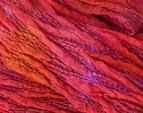We went to the local Rethynon bus station and bought return tickets then found the bus we needed. Driver says no. We said that man said yes. Driver winds down window and with much shouting and arm waving conversed with man in office who leaned back in his chair and laughed! (At us or the driver?)
We new this was the last bus of the day but we thought we would be dropped at the monastery, the bus go to the end of its run and pick us up on the way back. But no, we suddenly realised we were turning around and heading back the way we had come. We followed the same road for a while then turned into a side road. The bus stopped and we were told it was Monastery Irene and we should get out. So much for our return tickets as the bus disappears into the distance.
We had a lovely visit with a nun showing us around the Monastery, then the shop which she admitted didn't have much stock as it was the end of the season. I did buy a wee bag in the tradional inlay technique of the area. I found out later that this is also done by embroidery with a needle and thread.
Then I was taken to the loom room. The loom in operation was about 60" wide and had 4 shafts but 1 & 2 and 3 & 4 were strapped together and operated as tabby. A fly shuttle was used. A "usually reliable man" wound the warp on the beam, all 800 metres of it and this took about 2 years to weave off. But the nun was having trouble with threads at one end of the beam not making a proper shed and breaking every time the shuttle was thrown. I hope she has the problem fixed now. She used mostly linen thread from France for the fabric and DMC pearl cotton for the inlay. Occasionally silk from northern Greece was used for the weft, particularly on table clothes.

Then she asked us how had we come. Oooh, no one has come by local bus before, everyone comes by taxi. We understand why. When we said we would have to walk the 5 km to the coast and catch a bus from there she pointed us in the direction of a one lane service road and we had a lovely walk about 4 km down hill past olive groves to the coast.



No comments:
Post a Comment